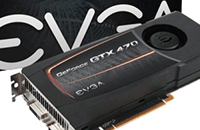Now that we know the differences between the GTX 470 boards, we move on to the next most important question: What is the overclocking limit of the GTX 470? Let’s find out.
Following is the overclocked speeds used, including stock PCI-E BIOS settings. Each clock setting was verified stable using the FurMark Extreme Burning test. 10 MHz higher on any of the 3 clocks began producing artifacts. Note that occasional artifacts don’t mean that the limit has been reached, but I wouldn’t tweak my car engine so that it drove around occasionally backfiring. Our various tests were conducted using the EVGA Precision tool and use both the NVidia 197.55 (came in the box) and 197.75 drivers (latest from Nvidia site).
Unfortunately, this card produces %30 more heat than its comparable ATI competitor. During the Extreme Burning test, GPU temps hovered at 73°C. This is, of course, with 100% fan power. The fan sounds like a jet engine at 100%, so I only have that on for benchmarking. Notice that your results may vary, but you will easily be able to set your clocks higher than the Superclocked editions of this card.
Overclocking Limits (fixed percentages 08/11/2010)
| Clock | Starting | OC Limit | Increase |
|---|---|---|---|
| Core | 608 MHz | 800 MHz | 31.5 % |
| Memory | 1674 MHz | 1920 MHz | 14.7 % |
| Shader | 1215 MHz | 1600 MHz | 31.7 % |











